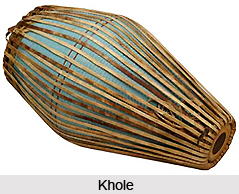 Khole is a percussion musical instrument used in Northern and eastern India. It is used most often in religious and devotional musical performances. The instrument is held to be so sacred that it is always reverentially referred to as the Sree Khole and not merely as the Khole. The drum is said to have been introduced to Bengal and made popular there by the profound mystic singer Sree Chaitanya who was also responsible for the wide spreading of Bhakti and the congregational singing of Keertan. Likewise its prominent place in the devotional Sankeertan song in the various Sattras (monasteries) of Assam is due to the saint philosopher Sree Sankardev. In the ISKCON and Goudiya Vaishnava Societies, the Khole is the prime instrument used to accompany Kirtans and Bhajans. The Khole is also used in Bengali folk and semi-classical music.
Khole is a percussion musical instrument used in Northern and eastern India. It is used most often in religious and devotional musical performances. The instrument is held to be so sacred that it is always reverentially referred to as the Sree Khole and not merely as the Khole. The drum is said to have been introduced to Bengal and made popular there by the profound mystic singer Sree Chaitanya who was also responsible for the wide spreading of Bhakti and the congregational singing of Keertan. Likewise its prominent place in the devotional Sankeertan song in the various Sattras (monasteries) of Assam is due to the saint philosopher Sree Sankardev. In the ISKCON and Goudiya Vaishnava Societies, the Khole is the prime instrument used to accompany Kirtans and Bhajans. The Khole is also used in Bengali folk and semi-classical music.
The body of the Khole is made of jack or mango wood. When it is produced of earth, it is often referred to as the Mridanga. The length of body is about 75 cm. One side of the Khole is much smaller than t he other. The right face is of 15 cm diameter and the left of 25 cm. The convexity is asymmetrical, being nearer to the left. Similar to the Pakhavaj, the drum heads are made of two membranes, the inner complete skin and the outer peripheral ring. The membranes may be made of cow or goat skin. The smaller side, known as Dayan, and the bigger side, known as Baya, usually has three-layered heads. In addition to this is a special central region of rice paste, glue, and iron. This central region is known as the Syahi. The two faces are held by braids which are connected by leather straps. There are no tuning blocks, for the pitch of the drum is adjusted and fixed by suitable tension of the braces. While making the Sree Khole, even the process of striking the plaits as in the Tabla or the Pakhavaj is not resorted to. In performance, the drum is held horizontally and is played with the palm and fingers of both hands.




